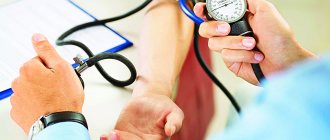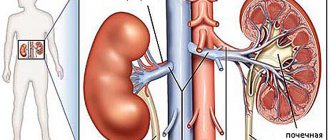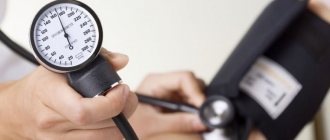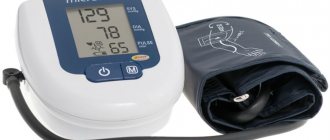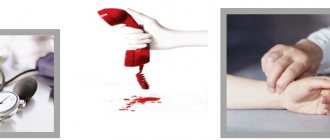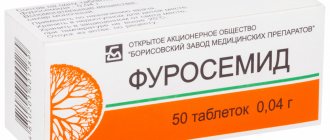15 minutes
1453 views
Hypertension is a condition of the body in which the blood vessels constantly experience increased blood pressure: systolic blood pressure equals or exceeds 140 mm Hg and/or diastolic blood pressure equals or exceeds 90 mm Hg.
The diagnosis of “hypertension” is made in cases where, according to pressure measurements taken on two different days, the value of systolic pressure on both days is equal to or exceeds 140 mmHg. Art. and/or the diastolic pressure value on both days is equal to or greater than 90 mmHg. Art.
The danger of this condition is the risk of damage to the heart or blood vessels in other organs, such as the brain and kidneys.
Uncontrolled hypertension can lead to heart attack, enlarged heart, and eventually heart failure. Blood vessels can develop dilations (aneurysms) and develop vulnerable spots where the vessels are more likely to become clogged and rupture. Pressure in the blood vessels can lead to bleeding in the brain and stroke. Hypertension can also lead to kidney failure, blindness, and cognitive impairment.
Hypertension is called the “silent killer”. Most patients with hypertension are not even aware of the problem, since hypertension often does not give warning signs and is asymptomatic.
We invite everyone to use the Cardiac Diagnostics medical program to assess the condition of your cardiovascular system and receive advice from all the necessary specialists.
Risk factors for developing hypertension
Stress, mental and mental fatigue
Research shows that hypertension is more common in people whose life is associated with constant nervous tension. For example, in residents of large cities, hypertension is much more common than in people living in rural areas.
Hypertension and stress are inextricably linked, so it is necessary to treat both ailments.
Every fourth man and every fifth woman in the world has high blood pressure
Research shows that hypertension is more common in people whose life is associated with constant nervous tension. For example, in residents of large cities, hypertension is much more common than in people living in rural areas. Hypertension and stress are inextricably linked, so it is necessary to treat both ailments.
Complications of hypertension are responsible for 9.4 million annual deaths worldwide (WHO)
Physical inactivity
Physical inactivity is a decrease in muscle load due to a sedentary lifestyle. A modern city dweller does little physical labor, prefers to use vehicles even for short distances, instead of walking, and spends his free time in front of the computer or TV. Only 1% engage in recreational sports and 5% do morning exercises.
As a consequence, this lifestyle leads to significant changes in all life-supporting systems of the body, especially the cardiovascular and nervous systems.
The combination of physical inactivity and stress makes a person extremely vulnerable to hypertension and its complications. Adrenaline produced during times of stress stimulates the production of glucocorticoids, which, in turn, stimulate an increase in blood sugar and an increase in blood pressure.
In an immobilized body, adrenaline and sugar, instead of “burning out” with the release of energy, remain in the blood vessels for a long time and lead not only to a long-term increase in pressure, but also to heart attacks and strokes.
Overweight
In order to determine whether you are overweight or not, body mass index is used. It is calculated as the ratio of body weight in kilograms to the square of height in meters. If the result obtained exceeds 25 kg/sq.m for young people and 27 kg/sq.m for older people, but does not exceed 30 kg/sq.m, then this means that there is excess weight. If the index value is above 30 kg/sq.m, then in this case we are talking about clinically pronounced obesity.
More than half of patients with hypertension are obese.
Obesity is a chronic metabolic disease in which excess fat accumulates in adipose tissue.
Numerous scientific studies have proven that reducing excess fat mass by 5-10% leads to a decrease in high blood pressure and improved control of the disease.
Other risk factors
Unhealthy diet - excessive salt intake, high content of saturated fats and trans fats in food, insufficient consumption of vegetables and fruits. As well as the use of tobacco and alcohol.
Uncontrollable risk factors include family history, age, and underlying medical conditions such as diabetes or kidney disease.
Treatment of the disease
Treatment of hypertension is complex and depends on the stage, severity, causes, gender and age of the person and other factors. The disease cannot be completely cured, but the patient’s condition can be significantly improved and the onset of life-threatening complications can be delayed for a long time. Treatment can be non-drug and medicinal.
Non-drug therapy. It involves adjusting the patient’s lifestyle. Most patients do not attach much importance to it, considering it frivolous, but such treatment is the key to success.
First of all, it is necessary to review the diet of the sick person, reduce the intake of carbohydrates and fats, and increase the intake of proteins and vitamins. You should reduce your caloric intake, which will subsequently lead to a reduction in cholesterol and body weight. It is also necessary to normalize the drinking regime, reduce salt consumption to 5 g per day.
When treating hypertension in older people, spa therapy and climatotherapy are especially recommended. The doctor prescribes therapeutic exercises and physical education. Reducing anxiety levels and using psychotherapy methods are helpful.
Pharmacological treatment. Quite often, in the treatment of hypertension, the principle of “steps” is used when prescribing medications. Groups of drugs are prescribed in the required sequence, since drugs have different degrees of impact in the mechanism of increasing blood pressure. When a person achieves a stable decrease in blood pressure, the doctor transfers the patient to maintenance therapy.
- When treating grade 1 high blood pressure, one antihypertensive drug is usually prescribed, which is taken on an outpatient basis under the supervision of a specialist. Medicines are prescribed in courses lasting several weeks.
- When treating stage 2 hypertension or when monotherapy is ineffective, the doctor usually prescribes 2 drugs. Therapy is carried out in a hospital. If an elderly person experiences a stable decrease in blood pressure, the patient continues treatment at home.
- Treatment of stage 3 hypertension requires an individual approach. It is carried out in a hospital until the condition stabilizes. The doctor evaluates the results of the examinations and prescribes a special course of treatment for stage 3 hypertension.
Prevention of hypertension
Every adult should monitor their blood pressure. In case of high blood pressure, you should consult a doctor.
People with high blood pressure who also have high blood sugar, high blood cholesterol or kidney problems are at increased risk of heart attack and stroke. Therefore, it is important to regularly check your blood sugar levels, blood cholesterol levels and urine protein levels.
There are a number of specific steps everyone can take to minimize the risk of developing high blood pressure and its adverse effects:
Mental balance
Mental well-being and a positive emotional state are essential conditions for maintaining health. What is especially important for patients with hypertension or predisposed to its development, because the disease is directly related to an inadequate response to stress.
It is necessary to learn how to manage stress in healthy ways such as meditation, various types of psychotherapy and positive social contacts.
Specialists of the Peredelkino Cardiological Sanatorium Center: neurologists, psychotherapists, cardiologists will give you comprehensive recommendations and teach you how to resist stress.
Walking in the fairytale forest surrounding the sanatorium and active recreation in nature will give you a good boost of energy. Getting to know the local attractions will give you peace of mind.
Physical activity
The second component of the prevention of hypertension is sufficient physical activity, without which we all suffer to varying degrees from manifestations of physical inactivity.
For a city dweller, it would be optimal to walk for at least 1 hour every day in a forested area.
At the Peredelkino Cardiological Sanatorium Center, as part of the Cardioprevention program, dosed walking classes are held in Meshchersky Park, mechanical therapy in the gym, group water aerobics in the pool, and city sports competitions are held.
Patients with an already manifested disease should engage in physical therapy.
It is necessary to adhere to a regime of rational alternation of work and rest. Overwork of any type, both mental and physical, should not be allowed. Healthy physiological sleep is of great importance, during which the body rests from all stress. Patients at the initial stage of hypertension should sleep at least 8-9 hours a day.
Healthy eating
In the prevention of hypertension, proper nutrition or diet in clinically pronounced forms of the disease is of great importance.
Carbohydrates
Here you should give preference to vegetables and fruits, as this will allow you to get a sufficient amount of fiber, vitamins and minerals.
Squirrels
When choosing proteins, you should avoid or limit meat products in favor of dairy and plant-based ones.
Fats
Total fat intake should be reduced. Try to replace animal fats with vegetable fats, and among animal fats there should be more fish fats.
A diet with limited salt can be a cure for patients with hypertension. No more than 5 g (slightly less than one teaspoon) is allowed per day, which makes control over blood pressure levels much easier.
Maintain a normal weight
Reducing excess weight or treating obesity is the main factor that can lead to satisfactory control of blood pressure and even, in some cases, abandon drug correction of the latter.
An effective means for normalizing weight is diet therapy and various types of physical activity.
Rejection of bad habits
If a person is prone to drinking alcohol in large doses or smoking, then the risk of hypertension increases many times over.
Alcohol intake promotes spasm of peripheral vessels and increased blood pressure due to increased vascular resistance.
After smoking, cholesterol levels increase, which is due to the release of large amounts of adrenaline and norepinephrine from the adrenal glands. There is even such a medical term - nicotine hypertension.
Diagnostics
The diagnosis of hypertension is based on monitoring blood pressure at home (during exercise and at rest). You can monitor your blood pressure using automatic or manual pressure gauges.
When diagnosing hypertension in the clinic, the following is carried out:
- detailed questioning of the patient, accurate recording of all risk factors, the doctor identifies predispositions to the disease;
- clinical examination (the doctor measures the person’s pulse and blood pressure);
- daily monitoring of blood pressure (prescribed if necessary);
- conducting Holter monitoring, performing an electrocardiogram;
- determining the stability of blood pressure levels, minimum and maximum numbers, the effects of medications, etc.;
- consultations with a nephrologist, neurologist, endocrinologist;
- laboratory diagnostics (general analysis and biochemistry of blood and urine, levels of sodium and calcium, phosphates and uric acid, plasma potassium, etc.);
- chest x-ray;
- Ultrasound of the kidneys, heart;
- diagnostics using bicycle ergometry, load tests (if necessary).
Physical methods for preventing the development and exacerbations of hypertension
Hydrotherapy
Hydrotherapy (hydrotherapy) is a powerful means of recovery, prevention and treatment of hypertension. Water can affect the body as a temperature, mechanical or chemical irritant, and the choice depends on the need for one or another factor of influence.
The temperature factor is the most important in choosing a hydrotherapy technique. Skin capillaries expand and contract in response to exposure to water of varying temperatures. In this case, either an increase in blood flow or a decrease in it occurs. Cold water also slows and increases heart rate and increases blood pressure. Hot water lowers blood pressure, speeds up the heart rate and weakens heart contractions
Most often, to prevent exacerbations of hypertension, water at an indifferent temperature is used, which is indicated for excessive nervous excitability, irritability, cardiac dysfunction, and insomnia.
Hydrotherapy procedures are contraindicated for stage III hypertension.
Before using water procedures as a treatment, you should consult your doctor.
For hypertension stages I-II, rain, dust and circular showers are used using indifferent or warm water with moderate pressure from water jets.
Baths can be general and local; in case of hypertension they are used for therapeutic and preventive purposes. Medicinal baths for hypertension are limited to the use of pine extract.
You can see about the types of hydrotherapy at the Peredelkino Cultural Center here
Drug electrophoresis
This is the use of galvanic current for the purpose of interstitial non-invasive administration of various drugs. Under the influence of galvanic current, drug ions enter the skin and are retained under the anode area, which creates a kind of drug depot. The drug enters the bloodstream rather slowly, which increases the duration of its effect on the body. The body is also affected by the positive effects of galvanic current.
Electrophoresis is indicated in the initial stages of hypertension. At stage III, it is contraindicated. In addition, contraindications are neoplasms, acute inflammatory processes of any location, disorders of blood clotting processes, pronounced atherosclerosis, decompensated diseases of the cardiovascular system, kidneys, pregnancy, individual intolerance to galvanic current.
At the Peredelkino Cultural Center, various types of physiotherapy are used. More details can be found here
Therapeutic exercise (physical therapy)
Therapeutic exercise is used at all stages of hypertension to prevent hypertensive crises and complications of the disease. It includes any available types of physical exercise - dosed walking, morning exercises, health path, swimming.
The best way of prevention is morning exercises or exercises, which allows you to prepare the body for a working day, stimulates the processes of nervous regulation of blood circulation and the reactivity of the vascular system as a whole.
If the disease has already developed, then you should add a daily complex of therapeutic exercises to the morning exercises.
At the Peredelkino Sports and Fitness Center, individual and group physical therapy classes are conducted under the guidance of professional exercise therapy instructors.
Drug therapy
The selection of medications for the treatment and prevention of exacerbations of hypertension should be carried out only by a doctor.
Drug therapy becomes necessary already at the second stage of the disease, when blood pressure reaches significant levels with regular measurements.
The main principle is the individual selection of antihypertensive drugs for each patient.
Dear readers, the articles are for informational purposes only. Before using the recommendations, you should consult your doctor.
One of the priority areas of the State Program for Reforming the Health Care System of Uzbekistan is the development of primary health care and improving the structure of primary health care institutions. Over the past 10 years, rural medical centers have been organized in the republic and a new specialty has been introduced - a general practitioner who provides general medical care: protecting the health of the population, promoting a healthy lifestyle, diagnosing, treating and preventing diseases.
The most common condition that requires constant monitoring by general practitioners is arterial hypertension (HTN), which is considered as a non-infectious pandemic that affects the socio-economic losses of society [1]. 30-40% of the adult population has a blood pressure (BP) level of more than 140/90 mmHg. [2]. In the republic, according to the Republican Specialized Scientific and Practical Center of Cardiology, the prevalence of hypertension is 18-20% [3]. For a long time, the disease is asymptomatic, causing damage to target organs: the heart, brain, kidneys, peripheral vessels, contributing to the development of cardiovascular complications and increasing mortality rates [4]. In developed countries, as a result of preventive measures, the mortality of patients with hypertension has significantly decreased due to systematic monitoring of blood pressure levels, timely drug correction and achievement of its target level [5]. This control is carried out by general practitioners or family doctors. Many studies have been devoted to assessing the effectiveness of the use of various groups of antihypertensive drugs, and recommendations have been developed for the diagnosis, prevention and treatment of hypertension [6]. Many doctors know and apply the recommendations, however, rates of cardiovascular morbidity (CVD) and especially mortality continue to rise, more often death occurs from developed complications in the prehospital stage; According to the literature, death from stroke is recorded in patients at home in 56.3% of cases, in a hospital much less often - in 18.9% [7].
The purpose of this study is to evaluate the preventive measures carried out in some clinics in Tashkent and to develop recommendations for the implementation of hypertension prevention in primary health care.
Material and methods
A questionnaire was previously compiled based on the standard for diagnosis and treatment of hypertension - “Clinical guidelines for the diagnosis, treatment and prevention of arterial hypertension in primary healthcare” created by the Center for Evidence-Based Medicine of the Tashkent Institute for Advanced Medical Studies [3]. A questionnaire to assess the knowledge of doctors was filled out by teachers of the training center for the retraining of general practitioners. They also tested, by observation, the skills of counseling patients with hypertension, measuring blood pressure by doctors, and interpreting ECGs. The purpose of the examination, dispensary records, and recommendations for drug treatment were checked using the outpatient records of patients with hypertension.
The study was carried out in 6 experimental city clinics in 3 districts of Tashkent, where general medical practice was introduced, 113 general practitioners were interviewed, and 258 outpatient records of patients with hypertension were analyzed.
results
During the survey, it was revealed that none of the doctors conducts total blood pressure screening for each resident of the assigned area. Blood pressure measurements for every patient over 18 years of age, regardless of the purpose of the visit to the city clinic, according to the standard (clinical guidelines), are carried out competently by 41 (36.3%) general practitioners. However, more than half of them (57.5%) measure blood pressure only in patients with cardiovascular diseases, elderly patients, or at the request of the patients themselves. Only 6.2% of clinic doctors measure blood pressure in people with risk factors. All the doctors surveyed knew 10 consecutive steps for measuring blood pressure, but during observation of the patient’s appointment it turned out that 78 (69.1%) doctors performed them correctly, the rest (30.9%) did not complete the steps completely.
Assessing the skills of examining a patient with hypertension during medical examination required additional examination and identification of risk factors, target organ damage and the presence of associated conditions. 8 (7.1%) doctors did not fulfill this requirement of the standard, 81 (71.7%) doctors partially fulfilled this requirement, and only 24 (21.2%) conducted the dispensary examination correctly.
Based on the recommendations of the Clinical Guidelines, general practitioners should interpret ECG, but, as observation showed, 37 (32.7%) of them do not fully master this skill, 62 (54.9%) doctors were able to show a basic level of knowledge, 11 (9 .7%) - advanced level of knowledge, and 3 (2.7%) were unable to completely decipher the ECG.
When consulting patients with hypertension, doctors should inform them about the disease and its complications and recommend non-drug treatment. Only 25.7% of surveyed doctors informed patients about the disease in sufficient detail (Table 1).
With regard to lifestyle changes, it was more often (72.4%) recommended to quit smoking, reduce the consumption of alcoholic beverages and salty foods, less often (17.8%) - regular physical activity and weight loss.
After observation of the appointment, 258 outpatient records of patients with hypertension registered at the dispensary in these clinics were analyzed. Only 12.6% of them fully met the standard (having a full examination every 6 months and monthly blood pressure measurement by a visiting nurse). According to the majority of other outpatient records (82.4%), a partial examination was carried out or monthly records of BP values were missing. The next criterion for compliance with the standard was the analysis of outpatient records for treatment purposes. According to the standard, patients with newly diagnosed hypertension should be prescribed β-blockers or thiazide diuretics, and aspirin preparations as disaggregants (in the absence of contraindications) [3]. 12% of the studied maps did not meet the standard (Table 2).
Thus, the analysis of the work of general practitioners on the prevention of hypertension in city clinics showed the low quality of early detection of patients with hypertension, an insufficient level of dispensary observation, filling out outpatient cards and prescribing treatment.
Discussion
Primary prevention is the activity of identifying and influencing risk factors to prevent the development of the disease. In developed countries, mortality from cardiovascular complications has decreased significantly due to improved primary prevention with control of risk factors, including lifestyle changes, and public awareness of risk factors and symptoms of the disease [8]. General practitioners should promptly identify risk factors in an outpatient setting or at home and carry out preventive measures before symptoms of the disease develop [9]. To do this, it is necessary to form groups of people with risk factors and carry out additional work with them to inform them about the impact of factors on the occurrence of diseases, their impact on the quality and life expectancy, involving the entire medical staff of the institution in this work. Preventive measures are quite universal, easy to implement and do not require additional costs; they are aimed at improving the patient’s lifestyle as a whole.
Secondary prevention includes early diagnosis of the disease in the preclinical stage. For a long time, hypertension is asymptomatic, so the only method for early detection of increased blood pressure is its constant measurement. Every employee of a medical institution (receptionist, nurse, nurse, doctor of any specialty) must be able to correctly measure blood pressure [10]. Effective control of blood pressure in patients with hypertension should be mandatory for both the patient and medical personnel.
Another important tool for the early detection of elevated blood pressure levels is screening programs, during which pressure is measured for all those who come to the clinic, regardless of the purpose of the visit, and among residents of a designated area over 18 years of age - either at home or on call to the clinic. However, as the results of the study showed, such screening was not carried out in the clinics studied.
According to the recommendations of the WHO Expert Committee on Hypertension, when elevated blood pressure is detected, patients must be examined to determine the cause of the increase in blood pressure [6]. The minimum examination in a city clinic should include a urine test for protein, determination of blood sugar levels, creatinine, cholesterol, and ECG. If pathological changes are detected, an additional examination is carried out in a diagnostic center to establish the cause of hypertension and exclude increased blood pressure due to other diseases [3].
If elevated blood pressure levels are repeatedly detected, according to clinical guidelines, it is recommended to determine the diagnosis of hypertension, indicating the degree of hypertension based on blood pressure indicators, and stratify the risk of cardiovascular complications based on existing risk factors, target organ damage and the presence of associated diseases. Determining the risk level for each individual patient provides a clear picture of the long-term prognosis and facilitates decisions about the timing of initiation, the nature of antihypertensive therapy and the target level of blood pressure reduction [8].
The choice of drug therapy must comply with international standards based on the principles of evidence-based medicine. Clinical guidelines for hypertension recommend the use of β-blockers and thiazide diuretics as first-line drugs, and in the presence of contraindications, second-line drugs [3].
An equally important aspect of secondary prevention is improving awareness of the disease and following doctors’ recommendations for treatment and control of blood pressure levels [11]. The commitment of the patient with hypertension and his family members to a healthy lifestyle, monitoring the condition and blood pressure levels will improve the quality of treatment and prevention of this disease. General practitioners, together with the patient, must decide to initiate treatment, discuss the benefits of drug therapy, the likely prognosis of the disease without treatment, and the development of possible complications [12]. The patient's participation in discussing the treatment plan and making a decision about the need for treatment will increase his interest and responsibility for the results of treatment.
Finally, the prevention of hypertension requires regular monitoring of doctors’ knowledge and skills in patient management tactics; it is necessary to identify gaps and initiate training in the system of advanced training and continuing professional education [13]. Providing medical care to patients with hypertension in accordance with clinical guidelines developed according to the principles of evidence-based medicine will improve the diagnosis and treatment of patients, prevent target organ damage and the development of associated diseases.
The main goal of tertiary prevention of hypertension is the prevention of cardiovascular complications, disability and mortality due to them. It is also aimed at the rehabilitation of the patient. As evidenced by the results of large multicenter studies on the diagnosis and treatment of hypertension, the main method of preventing the development of cardiovascular complications leading to death in patients with hypertension is timely monitoring of the patient’s condition and his dynamic monitoring - tertiary prevention measures [11, 14]. This policy of managing patients with hypertension in many developed countries has reduced cardiovascular complications and mortality rates [10]. In the republic, when a diagnosis of hypertension is made, patients are required to be registered at a dispensary, their condition is monitored over time, and a mandatory systematic examination is carried out every 6 months. From the results obtained, it is possible to determine the progression of the disease with the involvement of damage to new target organs or the presence of other associated diseases, and assess the risk of developing cardiovascular complications [3]. At low and medium risk, non-drug treatment is recommended; at high risk, non-drug treatment and drug therapy are recommended; at very high risk, the doctor should discuss the possibility of inpatient treatment with the patient. It is mandatory to monitor the treatment of patients at home: constant use of an antihypertensive drug in the specified dosage and recommended regimen, taking antiplatelet agents (aspirin, thrombo ACC, cardiomagnyl) for the prevention of cardiovascular and cerebrovascular complications. To increase the effectiveness of treatment, it is necessary to inform patients about the disease; an important step in the management of hypertension is the doctor’s conversation with the patient and his education [11]. Awareness of patients about their existing diseases, training in the basics of assessing their condition and monitoring blood pressure levels can alleviate the course of the disease and prevent the development of complications [15]. Patients should know the signs of possible complications of the disease, regularly measure blood pressure, undergo a clinical examination every 6 months, and most importantly, follow the doctor’s recommendations for non-drug treatment and constantly take medications.
Conclusion
Early identification of risk factors, elevated blood pressure, lifestyle changes, recommendations for non-drug treatment and controlled drug therapy will prevent target organ damage and the development of associated conditions. Prevention of complications of hypertension remains one of the most important medical and social problems. Clarification of all aspects of this problem, development of technology for solving it at the primary health care level can be an important component in reducing the incidence of hypertension and mortality from its complications, therefore the development and implementation of modern methods of primary, secondary and tertiary prevention acceptable for primary care is a very urgent task.

